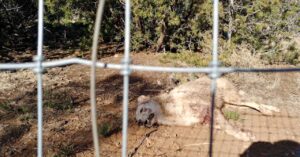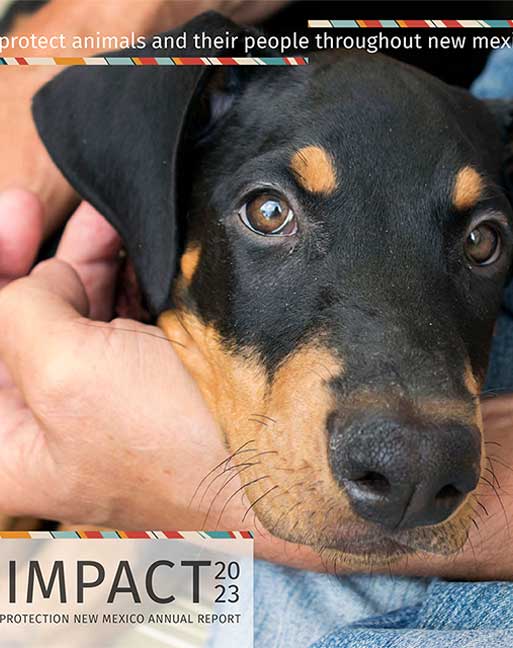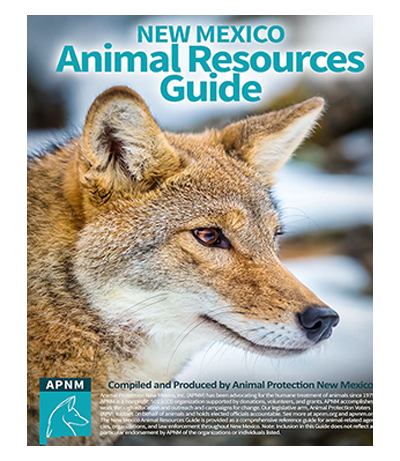Early last month, APNM’s cruelty response team waited with bated breath to hear the latest news from the District Attorney’s office for the Fourth Judicial District. Our Cruelty Response & Advocacy Director, who has spent the last several years working collaboratively with community members and law enforcement on one of the most egregious cases of animal hoarding in recent New Mexico history, had been subpoenaed to testify as a witness in court. The trial date was fast approaching, but there were hints that a plea deal was in the works with the defendant, Jessica Taylor. What would happen next was anyone’s guess.

Animal hoarding is a huge problem in New Mexico and nationwide, with suspected hoarders living in nearly every community. Since we began tracking data in 2015, APNM’s Cruelty Helpline has received over 100 complaints concerning suspected animal hoarding—and while some of these cases resulted in enforcement action and criminal charges, many did not. Those cases are surely just the tip of the iceberg in terms of the scope of New Mexico’s animal hoarding issue.
What Is Hoarding and Why Does It Happen?
A typical hoarding situation involves malnourished, sick animals living in filthy, cramped conditions, which, in some cases, require the premises to be condemned. Although animal hoarding is usually associated with large numbers of animals (sometimes up to 100 or more), inadequate care of the animals is the most important factor. The negative impacts of hoarding not only affect the animals, but also any of the humans who reside in the building or household. Most instances involve individuals or occasionally family units, but some of the worst cases have been found in purported rescues and sanctuaries—so-called “rescue hoarding.”
 Rescue hoarding happens when someone intends or claims to be “saving” animals from homelessness, cruelty, or euthanasia, and begins collecting animals on their property. But unlike a reputable rescue or sanctuary, often the animals in a rescue hoarding situation are kept in a space that is overcrowded and not cleaned of animal waste or trash; may not be provided adequate food, water, and veterinary care; and allowed to breed, thereby increasing the already suffering population of animals. Unfortunately, the person who is hoarding usually does not recognize that the animals in their care are actually suffering or dying—they firmly believe they are the only ones who can adequately care for their animals, and they often reject offers to adopt their animals. But because the hoarder markets themselves as a rescue organization, they sometimes have enablers in their community and/or support in the media, which makes it even harder for law enforcement to take appropriate action.
Rescue hoarding happens when someone intends or claims to be “saving” animals from homelessness, cruelty, or euthanasia, and begins collecting animals on their property. But unlike a reputable rescue or sanctuary, often the animals in a rescue hoarding situation are kept in a space that is overcrowded and not cleaned of animal waste or trash; may not be provided adequate food, water, and veterinary care; and allowed to breed, thereby increasing the already suffering population of animals. Unfortunately, the person who is hoarding usually does not recognize that the animals in their care are actually suffering or dying—they firmly believe they are the only ones who can adequately care for their animals, and they often reject offers to adopt their animals. But because the hoarder markets themselves as a rescue organization, they sometimes have enablers in their community and/or support in the media, which makes it even harder for law enforcement to take appropriate action.
Many hoarders suffer from a form of obsessive/compulsive disorder known as Hoarding Disorder, recognized in the DSM-5 in 2013 by the American Psychiatric Association.
 Thus, animal hoarding is often the manifestation of a longstanding psychological problem, and evidence has shown a low potential for rehabilitation. Individuals suffering from Hoarding Disorder are often in denial and fail to grasp the suffering they are causing and that conditions are not just bad for the animals; they are bad for the people involved too. Hoarders and the animals they keep need help—regardless of whether the hoarding occurs in a residence or at a shelter, rescue, or sanctuary.
Thus, animal hoarding is often the manifestation of a longstanding psychological problem, and evidence has shown a low potential for rehabilitation. Individuals suffering from Hoarding Disorder are often in denial and fail to grasp the suffering they are causing and that conditions are not just bad for the animals; they are bad for the people involved too. Hoarders and the animals they keep need help—regardless of whether the hoarding occurs in a residence or at a shelter, rescue, or sanctuary.
Obstacles to local law enforcement include inadequate laws, limited local resources and partners, and lack of training and knowledge about how to handle large-scale animal seizures and animal hoarding cases. In some cases, hoarding situations are allowed to go on for years, simply because local authorities don’t have a plan in place to deal the with aftermath of stopping the hoarding. In other cases, local authorities have “cleaned out” a local hoarding situation, only to see it recur because the Hoarding Disorder drives hoarders to continue their activities if there is no ongoing supervision.
Animal shelters can spend huge amounts of money and other resources caring for alleged hoarders’ impounded animals, taking resources away from the other services that animal shelters provide for the community. National groups like the ASPCA and HSUS have response teams available, but because they lack jurisdiction, local law enforcement must request their assistance. These teams travel across the US assisting law enforcement, but they can only respond to so many cases at a time.
The Jessica Taylor “Green Gates Sanctuary” Case
Reports of suspected hoarding involving Jessica Taylor came to the APNM Cruelty Helpline as early as 2017. Ms. Taylor, a woman in her 70s, has purported to operate a rescue called “Green Gates Sanctuary” at two locations in San Miguel County: Ilfeld, NM and Rowe, NM. Initially registered as a nonprofit in 2007, and even briefly serving as the local animal shelter for Las Vegas, NM, Green Gates Sanctuary later became a quintessential rescue hoarding issue that would trouble the communities of Ilfeld—and later Rowe—for years.
 After moving to Rowe, Taylor had reportedly left numerous dogs, cats, & goats behind in Ilfeld. A pack of the dogs was reported to be running at large and attacking and menacing the neighbors’ dogs and other animals. Neighbors were also concerned about the dogs on the property, which were reportedly killing and eating the goats. Neighbors started sending photos, videos, and statements as evidence, and the San Miguel County Sheriff’s Office sent officers to investigate.
After moving to Rowe, Taylor had reportedly left numerous dogs, cats, & goats behind in Ilfeld. A pack of the dogs was reported to be running at large and attacking and menacing the neighbors’ dogs and other animals. Neighbors were also concerned about the dogs on the property, which were reportedly killing and eating the goats. Neighbors started sending photos, videos, and statements as evidence, and the San Miguel County Sheriff’s Office sent officers to investigate.
In February 2019, at the Ilfeld, NM premises, the Sheriff’s Office served a warrant and seized 39 animals, mostly dogs. Deputies also discovered four dead dogs and a dead goat, as well as various unidentified animal bones among the trash, debris, and animal droppings. Ms. Taylor was charged with 10 counts of Extreme Cruelty to Animals and 25 counts of Cruelty to Animal under the New Mexico’s animal cruelty statute.
Meanwhile, the neighbors near Taylor’s Rowe, NM property had begun complaining to the Sheriff’s Office, reporting concerns for the many animals being kept there. The local shelter was overfull from the Ilfeld enforcement effort, and local resources were already overextended, so APNM strongly advised that the Sheriff’s Office request the assistance of a response team from the HSUS or ASPCA.
In August 2019, Taylor was arrested and jailed for violating her conditions of release in the Ilfeld, NM case, receiving new charges for allegedly resisting the deputies who arrested her in Rowe, NM—but while she was incarcerated, the situation for the animals at the Rowe property quickly deteriorated. Frustrated and concerned with situation on the ground, a group of activists entered the premises and removed all the animals—reportedly 61 dogs—armed with a surrender agreement Taylor had signed while in the San Miguel County Detention Center. Many of these dogs were unsocialized and terrified of people, but various rescues and individuals took them into their care. Five years later, we don’t know what ended up happening with all of these dogs.
The 2019 criminal cases against Jessica Taylor associated with the Ilfeld and Rowe properties have been a long battle. They were complicated and slowed by the COVID-19 pandemic, multiple changes in Taylor’s legal representation, and competency questions. The current status of these cases are as follows.
 Some good news in the Ilfeld case, maybe: As mentioned at the start, a plea agreement was in the works, and on November 6, 2023, the Jessica Taylor entered into a plea agreement, pleading guilty to 3 counts of Animal Cruelty (a misdemeanor) under the New Mexico cruelty statute. By order of the court, she will undergo a mental health evaluation, attend animal cruelty rehabilitation classes, and is not allowed to acquire or keep any new animals other than one dog and two cats she was allowed to keep under a previous agreement. The term of probation will be 3 years, and if the conditions are violated, the case will be reopened. If Taylor, now in her mid-70s, reoffends after the 3-year probationary period is over, the state cruelty statute specifies that any instances of Animal Cruelty will be prosecuted as Extreme Animal Cruelty (a 4th Degree Felony). Knowing that the recidivism rate for hoarders is nearly 100%, we continue to monitor the situation.
Some good news in the Ilfeld case, maybe: As mentioned at the start, a plea agreement was in the works, and on November 6, 2023, the Jessica Taylor entered into a plea agreement, pleading guilty to 3 counts of Animal Cruelty (a misdemeanor) under the New Mexico cruelty statute. By order of the court, she will undergo a mental health evaluation, attend animal cruelty rehabilitation classes, and is not allowed to acquire or keep any new animals other than one dog and two cats she was allowed to keep under a previous agreement. The term of probation will be 3 years, and if the conditions are violated, the case will be reopened. If Taylor, now in her mid-70s, reoffends after the 3-year probationary period is over, the state cruelty statute specifies that any instances of Animal Cruelty will be prosecuted as Extreme Animal Cruelty (a 4th Degree Felony). Knowing that the recidivism rate for hoarders is nearly 100%, we continue to monitor the situation.
Rowe case: The criminal case for Resisting, Evading, or Obstructing an Officer had been scheduled for a jury trial on December 6, 2023, but was dismissed by the prosecution on November 29, 2023.
What You Can Do
Instead of focusing on the specific hoarding case and animals described in this blog post, we encourage you to consider it a cautionary example of something that could happen—or might even already be happening—in your own community. Will your local animal control, law enforcement, shelter, and community resources be prepared? If you suspect animal hoarding, please don’t assume someone else will take care of the situation; instead, safely document and report any findings of neglect or cruelty to the proper legal authorities. If you need assistance doing so, call APNM’s Cruelty Helpline at 1-877-5HUMANE.
Photos courtesy of Janette Burch from the Green Gate Sanctuary/Jessica Taylor case




